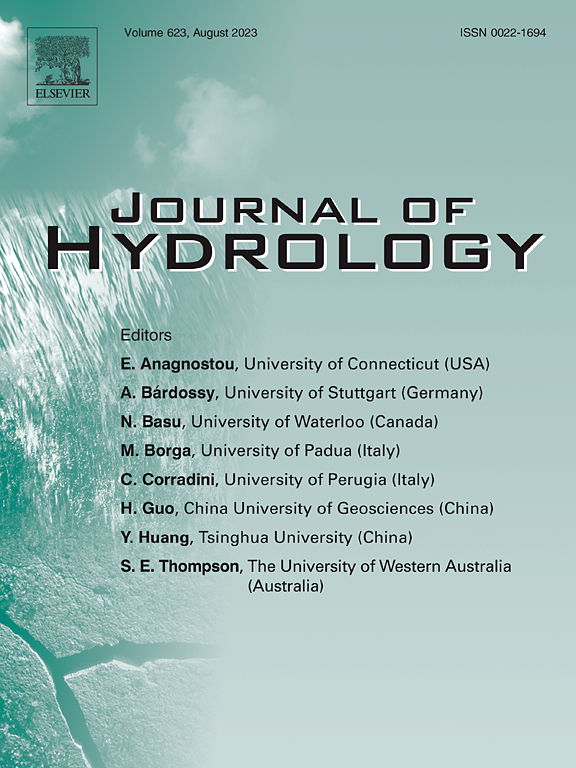A novel approach to increase accuracy in remotely sensed evapotranspiration through basin water balance and flux tower constraints
IF 6.3
1区 地球科学
Q1 ENGINEERING, CIVIL
引用次数: 0
Abstract
Remote sensing-derived evapotranspiration (RSET) products capture the spatiotemporal variations of evapotranspiration (ET) from field to basin scales with unprecedented details. However, their accuracy varies across RSET estimation methods and diverse hydroclimate regions. While ET modeling efforts to account for biophysical processes and controlling parameters have made good progress in recent years, a parallel approach of integrating in-situ ET with RSET could reduce biases in RSET products. Basin water balance ET (WBET) and flux tower ET are widely applied to evaluate RSET accuracy, yet such ET measurements are rarely used for RSET bias corrections, especially for large area applications. To address this issue, we propose a novel approach: the water balance equivalence (WABE) method, which generates spatially continuous WBET for correcting biases in RSET products. The WABE method computes synthetic WBET by integrating observed WBET and flux tower-derived FLUXCOM ET, which fills the spatial gaps of observed WBET and generates a spatially continuous WBET dataset. Synthetic WBET (2002–2015 annual average) of eight-digit hydrologic unit code (HUC8) basins across the conterminous United States (CONUS), constituting 44 % (887 out of 2035 basins) of CONUS basins, was determined within 2.0 % (RMSE = 12 %) of observed WBET at CONUS and between 1–12 % (RMSE = 3–33 %) across 18 regions in CONUS. With WABE-based bias corrections, the overall annual bias of RSET decreased from 10 % (RMSE = 34 %) to 6 % (RMSE = 26 %) across 37 flux tower sites. The WABE method offers a new approach for RSET accuracy improvement and shows great promise for large area implementations with a potential to yield substantial benefits for building accurate basin water budgets and water management decisions.
利用流域水量平衡和通量塔约束提高遥感蒸散发精度的新方法
遥感衍生蒸散发(RSET)产品以前所未有的细节捕获了农田到流域尺度上蒸散发(ET)的时空变化。然而,它们的精度在不同的RSET估计方法和不同的水文气候区域有所不同。虽然考虑生物物理过程和控制参数的ET建模工作近年来取得了良好进展,但将原位ET与RSET相结合的并行方法可以减少RSET产品的偏差。流域水平衡ET (WBET)和通量塔ET被广泛用于评估RSET精度,但此类ET测量很少用于RSET偏差校正,特别是在大面积应用中。为了解决这一问题,我们提出了一种新的方法:水平衡等效(WABE)方法,该方法生成空间连续的WBET来纠正RSET产品中的偏差。WABE方法通过对观测到的WBET和通量塔衍生的FLUXCOM ET进行积分计算合成WBET,填补观测到的WBET的空间空白,生成空间连续的WBET数据集。美国相邻地区(CONUS) 8位水文单元代码(HUC8)流域的综合WBET(2002-2015年平均),占CONUS流域总数的44%(占2035个流域的887个),在CONUS观测WBET的2.0% (RMSE = 12%)范围内确定,在CONUS 18个地区的1 - 12% (RMSE = 3 - 33%)之间确定。通过基于wab的偏差校正,37个通量塔站点的RSET总体年偏差从10% (RMSE = 34%)下降到6% (RMSE = 26%)。WABE方法为提高RSET精度提供了一种新的方法,并在大面积实施中显示出巨大的希望,有可能为建立准确的流域水预算和水管理决策带来实质性的好处。
本文章由计算机程序翻译,如有差异,请以英文原文为准。
求助全文
约1分钟内获得全文
求助全文
来源期刊

Journal of Hydrology
地学-地球科学综合
CiteScore
11.00
自引率
12.50%
发文量
1309
审稿时长
7.5 months
期刊介绍:
The Journal of Hydrology publishes original research papers and comprehensive reviews in all the subfields of the hydrological sciences including water based management and policy issues that impact on economics and society. These comprise, but are not limited to the physical, chemical, biogeochemical, stochastic and systems aspects of surface and groundwater hydrology, hydrometeorology and hydrogeology. Relevant topics incorporating the insights and methodologies of disciplines such as climatology, water resource systems, hydraulics, agrohydrology, geomorphology, soil science, instrumentation and remote sensing, civil and environmental engineering are included. Social science perspectives on hydrological problems such as resource and ecological economics, environmental sociology, psychology and behavioural science, management and policy analysis are also invited. Multi-and interdisciplinary analyses of hydrological problems are within scope. The science published in the Journal of Hydrology is relevant to catchment scales rather than exclusively to a local scale or site.
 求助内容:
求助内容: 应助结果提醒方式:
应助结果提醒方式:


